

For board testing, spring contact probes provide many design and performance advantages that are just not available with other contact options. Spring contact probes are proven to deliver consistent, reliable connections over multiple mating cycles. For overall reliability, long life and serviceability, spring loaded contact probes will always outperform stamped metal, elastomer, and wire mesh designs. In many applications they can deliver life expectancies beyond 1 000 000 cycles.
The ability to make a good, repeatable electrical contact is extremely important. That is why the choice of tip style is important. The application and target determine the tip style.
For testing pads
* Gold-plated pads - these are generally tested with a spherical radius tip or a flat tip. When testing gold pads, contamination and oxidation are not an issue. Using a less aggressive tip style minimises, if not eliminates, any damage or witness marks to the pad.
* Solder pads - contaminants and oxides are generally present on the surface of these pads so the tip must be sharp and aggressive enough to penetrate. Typically the tips used for this application are spear points, chiselled spears, chisels or 4-point crowns.
* Bare copper pads - similar to solder pads, except the contaminants are more difficult to penetrate. Therefore, a spear point or chisel spear is the best option.
For vias
The preferred tip choices for testing through holes or vias are the chiselled spear points or chisels. Only the edges of these tips contact the perimeter of the via or through hole.
For test sockets
For contacting area array packages in test sockets, a 4-point crown tip is recommended. This allows the ball or lead to centre within the plunger tip, preventing damage to the centre area where soldering must occur. The 4-point crown also allows the ball to self-centre within the tip. Single points are not considered a good option for this application in that they can slide off the ball and miss the target altogether. Cup tip styles may be used for this application, but contaminants have a tendency to accumulate in the tip and can then block current transfer. Routine cleaning and preventative maintenance have proved to eliminate these contact issues.
For interfaces
Chisel, chisel spears, or spherical radius tips are commonly used depending upon the type of contact which must be made.
For terminals
For contacting terminals inside a connector cup, serrated or 4-point crown tips are recommended. These tips will allow the terminal to self centre within the tip. As with the test sockets, cup tips have a tendency to accumulate contaminants in the tip and can then block current transfer.
Resistance is a primary concern when designing a probe and selecting materials and platings. As probes become smaller, their current carrying capacity decreases and their resistance increases. The material selected for the probe plays a key factor in maintaining or enhancing current carrying capacity and the resistance of the probe.
Barrel materials
The great majority of barrels are made from nickel silver because of its high strength, ductility and ability to be machined or deep drawn. Barrels that require a step flange for mounting in a printed circuit board must be machined. Barrels are, in essence, tiny tubes and are usually deep drawn. Alternative materials for machined barrels are beryllium copper or brass. For deep drawn barrels, alternative materials include phosphor- bronze or brass.
Nickel silver is an alloy of copper, nickel and zinc with excellent resistance to corrosion and does not oxidise or tarnish readily. As such, nickel silver barrels do not require plating. However, most nickel silver barrels are gold plated, to lower resistance and to ensure electrical performance. Gold-plated barrels can be used in almost any environmental extreme; a probe with a gold-plated barrel performs better.
Spring materials
Springs are manufactured from beryllium copper, stainless steel or music wire. Each of the three materials has unique characteristics. There are three primary considerations in choosing a spring material: operating temperature, resistivity and the required force.
* Beryllium copper can operate at up to 205°C for one hour and has a low resistivity and strength. Higher spring forces cannot be manufactured from beryllium copper.
* Music wire is used for extremely high force springs as it has a reasonable resistance, but cannot operate at temperatures above 120°C.
* Stainless steel has the highest operating temperature at 260°C for one hour, the highest resistance, and a strength between that of the other two materials.
Plunger materials
The base material is one of the most important factors determining the performance of a probe. Conductivity, strength and wear characteristics are the major criteria considered for plunger base material. Plungers are almost always made of beryllium copper. Tool steel and stainless steel plungers are other options, but as diameters decrease, steel becomes harder to machine. Steel is also more expensive, but it is harder and has a longer tip and edge life. It also has higher resistance.
Synergetix, locally represented by Connecta, offers a wide range of solutions to interconnect challenges.
Tip styles
Cup tips - A or G: a cupped tip style is often used to capture leads, terminals, connector pins and solder balls.
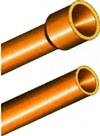
Spherical radius tips - J or D: choose spherical radius tips when you need a non-aggressive tip style to leave no indentations or visual marks at the targeted point of contact. Most often recommended for gold plated pads.
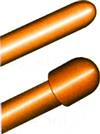
Flat tips - C or F: a flat non-aggressive tip style often used to contact gold plated card edge fingers. This nonaggressive tip style leaves no visible marks on its target.
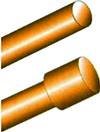
Spear point tip - B: an extremely sharp, aggressive single point used to penetrate contaminants and oxides. Used to contact pads and lands.
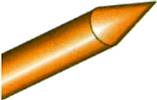
Serrated tip - H: capture leads, terminals and connector pins. Multiple points of contact make this a good tip style for higher current testing and poorly positioned targets.
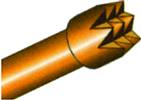
Chiselled spear point tip - SP: sharp, extremely aggressive tip style used to penetrate contaminants and oxides found on lands, pads and vias.
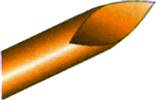
Chisel tips - S or T: three-sided chisel tip is ideal for contacting plated through holes or vias. Also used as an aggressive tip for lands and pads in contaminated applications.
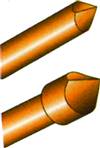
4-Point crown tip - U: ideally suited for contacting solder balls. Self-cleaning feature of 4-point crown tip makes it ideal for non-clean environments. Also used to contact lands, pads, or terminal posts.


© Technews Publishing (Pty) Ltd | All Rights Reserved